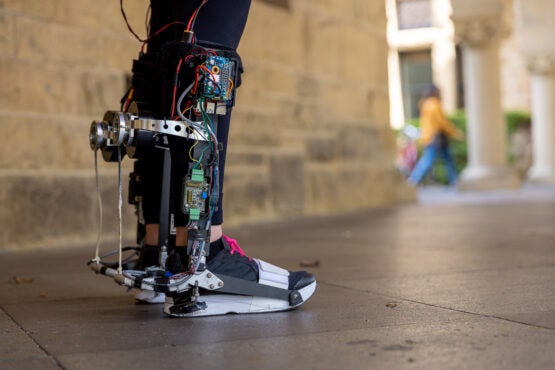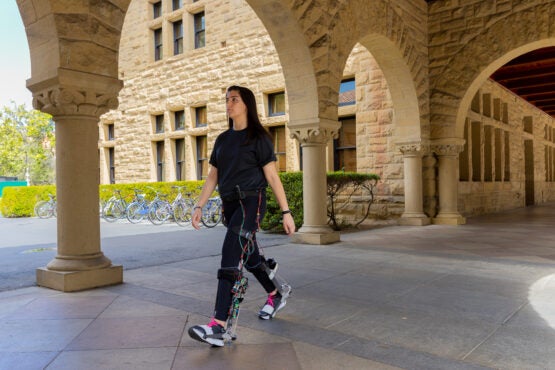Stanford exoskeleton walks out into the real world
After years of careful development, engineers have created a boot-like exoskeleton that increases walking speed and reduces effort outside of the lab.
For years, the Stanford Biomechatronics Laboratory has captured imaginations with their exoskeleton emulators – lab-based robotic devices that help wearers walk and run faster, with less effort. Now, these researchers will turn heads out in the “wild” with their first untethered exoskeleton, featured in a paper published Oct. 12 in Nature.
“This exoskeleton personalizes assistance as people walk normally through the real world,” said Steve Collins, associate professor of mechanical engineering who leads the Stanford Biomechatronics Laboratory. “And it resulted in exceptional improvements in walking speed and energy economy.”
This “robotic boot” has a motor that works with calf muscles to give the wearer an extra push with every step. But, unlike other exoskeletons out there, this push is personalized thanks to a machine-learning-based model that was trained through years of work using emulators.
“On a treadmill, our device provides twice the energy savings of previous exoskeletons,” said Patrick Slade, who worked on the exoskeleton as a PhD student and a Wu Tsai Human Performance Alliance Postdoctoral Fellow at Stanford. “In the real world, this translates to significant energy savings and walking speed improvements.”
The ultimate aim is to help people with mobility impairments, particularly older people, move throughout the world as they like. With this latest breakthrough, the research team believes the technology is ready for commercialization in the coming few years.
“The first time you put an exoskeleton on can be a bit of an adjustment,” said Ava Lakmazaheri, a graduate student in the Biomechatronics Laboratory who wore the exoskeleton in tests. “But, honestly, within the first 15 minutes of walking, it starts to feel quite natural. Walking with the exoskeletons quite literally feels like you have an extra spring in your step. It just really makes that next step so much easier.”
Exoskeletons for the real world
The major barrier for an effective exoskeleton in the past was individualization. “Most exoskeletons are designed using a combination of intuition or biomimicry, but people are too complicated and diverse for that to work well,” Collins explained.

A close-up of the untethered exoskeleton, which monitors movement using inexpensive sensors. (Image credit: Kurt Hickman)
To address that problem, this group relied on their exoskeleton emulators – large, immobile, expensive lab setups that can rapidly test how best to assist people and discover the blueprints for effective portable devices to use outside the lab. With students and volunteers hooked up to the emulators, the researchers collected motion and energy expenditure data to understand how the way a person walks with the exoskeleton relates to how much energy they are using.
These data revealed the relative benefits of different kinds of assistance offered by the emulator. It also informed a machine-learning model that the real-world exoskeleton now uses to adapt to each wearer. Unlike the emulator, the untethered exoskeleton can monitor movement using only inexpensive wearable sensors integrated into the boot.
“We measure force and ankle motion through the wearables to provide accurate assistance,” said Slade. “By doing this, we can carefully control the device as people walk and assist them in a safe, unobtrusive way.”
A 30-pound boost
The exoskeleton makes walking easier and can increase speed by applying torque at the ankle, replacing some of the function of the calf muscle. As users take a step, just before their toes are about to leave the ground the device helps them push off.

Ava Lakmazaheri, a graduate student in the Biomechatronics Laboratory, walking while wearing the untethered exoskeleton. (Image credit: Kurt Hickman)
When a person is first using the exoskeleton, it provides a slightly different pattern of assistance each time the person walks. By measuring the resulting motion, the machine learning model determines how to better assist the person the next time they walk. It takes only about one hour of walking for the exoskeleton to customize to a new user.
In tests, the researchers found their exoskeleton exceeded their expectations. According to their calculations, the energy savings and speed boost were equivalent to “taking off a 30-pound backpack.”
“Optimized assistance allowed people to walk 9% faster with 17% less energy expended per distance traveled, compared to walking in normal shoes. These are the largest improvements in the speed and energy of economy walking of any exoskeleton to date,” said Collins. “In direct comparisons on a treadmill, our exoskeleton provides about twice the reduction in effort of previous devices.”
The next step for the exoskeleton is to see what it can do for the target demographic: older adults and people who are beginning to experience mobility decline due to disability. The researchers also plan to design variations that improve balance and reduce joint pain, and to work with commercial partners to turn the device into a product.
“This is the first time we’ve seen an exoskeleton provide energy savings for real-world users,” said Slade. “I believe that over the next decade we’ll see these ideas of personalizing assistance and effective portable exoskeletons help many people overcome mobility challenges or maintain their ability to live active, independent, and meaningful lives.”
“We’ve been working towards this goal for about 20 years, and I’m honestly a little stunned that we were finally able to do it,” said Collins. “I really think this technology is going to help a lot of people.”
Additional Stanford co-authors of this work are Scott Delp, the James H. Clark Professor of Bioengineering and professor of mechanical engineering, and Mykel Kochenderfer, associate professor of aeronautics and astronautics. Collins is also a member of Stanford Bio-X, the Wu Tsai Human Performance Alliance and the Wu Tsai Neurosciences Institute, and an affiliate of the Institute for Human-Centered Artificial Intelligence (HAI). Delp is also director of the Wu Tsai Human Performance Alliance, a member of Stanford Bio-X, the Maternal & Child Health Research Institute, and the Wu Tsai Neurosciences Institute. Kochenderfer is also a member of Stanford Bio-X, the Wu Tsai Human Performance Alliance and the Wu Tsai Neurosciences Institute, and an affiliate of HAI.
This research was funded by the National Science Foundation, a Stanford Graduate Fellowship, and a Wu Tsai Human Performance Alliance Postdoctoral Fellowship.
To read all stories about Stanford science, subscribe to the biweekly Stanford Science Digest.
Media Contacts
Jill Wu, Stanford University School of Engineering: (386) 383-6061; jillwu@stanford.edu
 New Miniature Heart Could Help Speed Heart Disease Cures
New Miniature Heart Could Help Speed Heart Disease Cures
 Engineering and the human body
Engineering and the human body